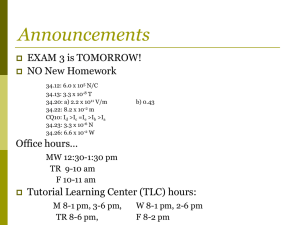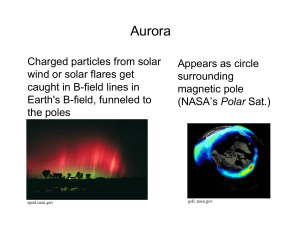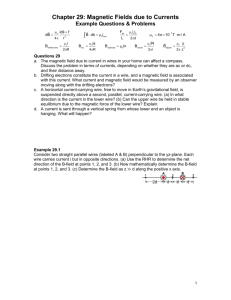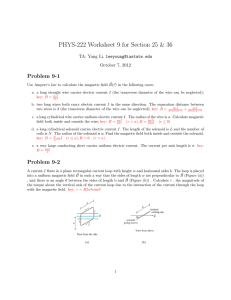Force on a square loop of current in a uniform B-field.
advertisement
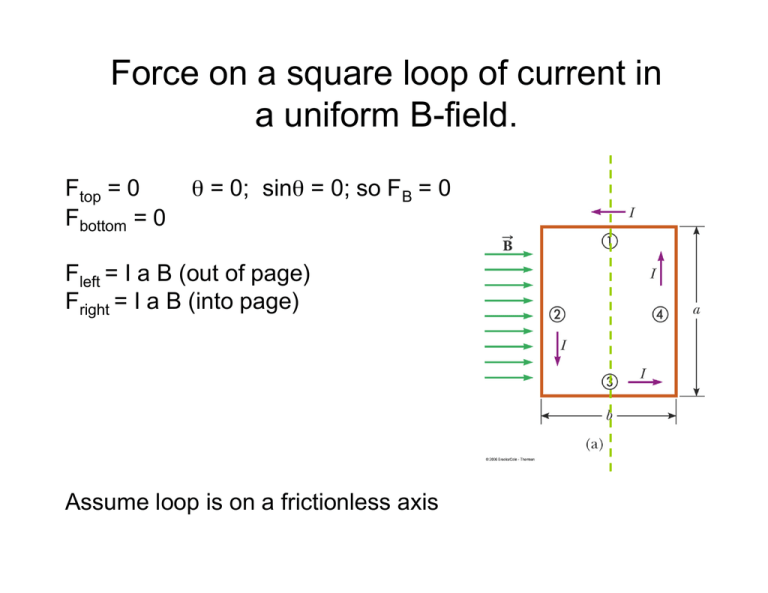
Force on a square loop of current in a uniform B-field. Ftop = 0 Fbottom = 0 θ = 0; sinθ = 0; so FB = 0 Fleft = I a B (out of page) Fright = I a B (into page) Assume loop is on a frictionless axis What’s the TORQUE on the current loop? Fig. 22.19b in text is the view along the axis, from the bottom towards the top. Reminder: torque = F × r = F r sinθ τ = Fleft b/2 + Fright b/2 = (B a I + B a I) b/2 = B I A A = area; θ=90º here Note direction of torque: clockwise For 1 loop: τ = BIA sinθ τmax = BIA For N turns: Total current = NI τ = BIAN sinθ Magnetic Moment µ = IAN µ always points perp. to the plane of the loops (points along the normal) τ= µB sinθ • The product IA is defined as the magnetic dipole moment, µ of the loop (for ANY loop shape) • SI units: A m2 • Torque in terms of magnetic moment: For a coil with N turns of wire: µ = NIA A coil consisting of 100 turns, each carrying 3A of current and having an area 0.2 m2, is oriented such that its normal makes a angle of 45º with a B-field of 0.5T. Find the total torque on the coil. What’s the direction of rotation? • B • × τ = BIANsinθ = (0.5T)(3A)(100)(0.2m2)sin45º = 21.2 Nm What would happen if the current were flowing in the opposite direction? × • • Same magnitude of τ, but rotation is now CW B normal vector • • • • × • • • × #1: θ=90º • #2: 0º < θ <90º × × #3: θ=0º #4: 90º < θ <180º torque acts to align plane of loop perpendicular to Bfield (align normal vector with B-field), as in #3 (if released from rest in this position, it won’t rotate) B normal vector • • • × • • • × #1: θ=90º × • #2: 0º < θ <90º × • #3: θ=0º #4: 90º < θ <180º As loop is rotating, what would happen if we switched the direction of current immediately after #3? The loop would continue to rotate clockwise! Electric motors •If direction of current is switched every time τ is about to change sign, then τ will never change sign! •Loop will rotate nonstop: we have an electric motor (electrical energy converted to mechanical (rotational) energy)! •Fans, blenders, power drills, etc. •Use AC current (sign changes naturally), or if you only have DC current available…. How do you switch the sign of current every half cycle? Use a "commutator" 22.7 & 22.9 Biot-Savart Law / Ampere’s Law Context: Previous sections discussed what happens when moving charges are placed in a previouslyexisting B-fields: charged particles/current-carrying wires experience magnetic force; a loop of wire experiences a torque. But what can GENERATE a magnetic field? Magnetic Field of a long straight wire In 1819, Oersted (Denmark) noticed that a magnet (compass needle) was deflected when current was drawn through a nearby wire. 1820: compasses in a horizontal plane: Magnetic Field of a long straight wire In 1819, Oersted (Denmark) noticed that a magnet (compass needle) was deflected when current was drawn through a nearby wire. 1820: compasses in a horizontal plane: Direction of deflection indicated “right-hand rule #2”: Magnetic Field of a long straight wire B-field lines form concentric circles: Notice that the iron filings are more strongly aligned closer to the wire Magnitude of B is the same everywhere along a given radius: |B| depends only on r (& physical constants) Magnetic Field of a long straight wire The magnitude of the field at a distance r from a wire carrying a current of I is µo = 4 π × 10-7 T.m / A µo is called the permeability of free space Ampere's Law: A general method for deriving magnitude of B-field due to sources of current 1. Construct a closed path consisting of short segments, each of length Δl 2. B = magnetic field B|| = Component of B-field PARALLEL to Δl Consider the product B|| * Δl 3. Sum of these products over the closed path = µ0 I Take advantage of symmetry. When B-field lines are circles, we choose a circular Amperian loop. B is already || to the circle at all points on the circle Σ B||Δl = B|| * circumference = B|| * 2 π r = µ0I Rearrange to get Example: A wire carrying 5A of current travels vertically into the page. At what distance r will the B-field equal the Earth's B-field (which points northward) at the surface, 0.5 Gauss? BEarth r × r = µ0I / 2πB r = (4π × 10-7 T m / A)(5A)/ (2 π 0.5×10-4T) = (2 × 10-7 T m / A)(5A) / 0.5×10-4T = 2 × 10-2 m = 2 cm. Example: A wire carrying 5A of current travels vertically into the page. At what distance r will the B-field equal the Earth's B-field (which points northward) at the surface, 0.5 Gauss? If 4 compasses are placed N,S,E,W of the wire at this radius, how will each compasses' needle be deflected? BEarth r × r = µ0I / 2πB r = (4π × 10-7 T m / A)(5A)/ (2 π 0.5×10-4T) = (2 × 10-7 T m / A)(5A) / 0.5×10-4T = 2 × 10-2 m = 2 cm. Example: A wire carrying 5A of current travels vertically into the page. At what distance r will the B-field equal the Earth's B-field (which points northward) at the surface, 0.5 Gauss? If 4 compasses are placed N,S,E,W of the wire at this radius, how will each compasses' needle be deflected? BEarth r × r = µ0I / 2πB r = (4π × 10-7 T m / A)(5A)/ (2 π 0.5×10-4T) = (2 × 10-7 T m / A)(5A) / 0.5×10-4T = 2 × 10-2 m = 2 cm. The E compass will spin freely (FB_Earth = FB_wire). The W compass will really point north, as it feels 2 * FB_Earth The N compass will point NE The S compass will point NW A power line 20m above the ground carries a current of 1000 A from E to W. Find the magnitude and direction of the B-field due to the wire at the ground below the line, and compare it to the Earth's B-field. Repeat for a wire 10m above ground. At 20m: B = µ0I / 2πr = (4π × 10-7 T m / A * 1000 A) / (2 π 20m) = 1 × 10-5 T -- about a factor of 3-5 smaller than the Earth's B field (0.3-0.5 Gauss). At 10m: B(r=10) = 2 × B(r=20) = 2 ×10-5 T -- still just smaller than the Earth's B-field Direction of B-field when you’re below the wire: south B-field at the center of a current-loop: BX Example: A Co-axial cable Inner conductor and outer conductor of radius Rout carrying currents in opposite directions. I What's B at r > Rout? I KEY: Remember superposition = vector addition: Total B-field from 2 sources = sum of B-fields from each source! +I + –I = zero total current, so B-field = 0. Example: B(r), inside wire: Ex. 22.7, p. 749 Use Ampere’s Law to derive that inside a wire with a uniform current distribution, B(r) is proportional to r. Recall the case of the electric field E(r) inside a wire with a uniform charge distribution: E(r) is also proportional to r. Outside a long, straight wire, both E and B as proportional to 1/r. 22.10: Stack of current loops = solenoid When the loop are spaced together tightly enough, the B-field inside is strong and rather uniform, and B-field outside is essentially negligible. Commonly used in electromagnets, devices used to convert electrical current to magnetic field. N S B-field in the center of a solenoid Use Ampere's Law; choose a closed loop as follows: Only segment 1 contributes: B||Δl = 0 for other segments. BL = µ0(NI) B = µ0I (N/L) = µ0In (n=N/L) Example: An electromagnet consists of 100 turns of wire, and the length is 3.0 cm. The wire carries 20 Amps of current. What's the Bfield at the center of the magnet? B = µ0I (N/L) = 4π × 10-7 T m / A * 20 A (100/0.03m) = 0.084 T B-field of a toroid (ex. 22.8) lbl.gov ΣB||Δl = B 2πr Tokamak: used for fusion energy research enclosed current on blue line = µ0 N I B = µ0 N I / 2πr B-field higher towards inner radius (not perfectly uniform), but uniform along each radius 22.11: Magnetism in Matter / Magnetic Domains Magnetic materials owe their properties to magnetic dipole moments of electrons in atoms Classical model for electrons in atoms: 1.Orbital motion of electron: like a loop current (but B-field produced by 1 electron can be cancelled out by an oppositely revolving electron in the same atom) 2. “spin” of individual electrons produces much stronger Bfield: each electron itself acts like a magnetic dipole Magnetic Domains Magnetic domains (10-4 - 10-1 cm): Each domain has a substantial fraction of atoms with magnetic moments coupled. They're separated by domain boundaries. Ferromagnetic materials (Fe, Co, Ni): have these domains. Spins are randomly oriented, but when an external B is applied, domains tend to align with magnetic field; domain boundaries adjust accordingly. Result: material produces its own internal B (Bnet = Bexternal + Binternal) Re-cap: Soft magnetic materials (e.g. Fe): Easily magnetized in presence of external B, but doesn’t retain magnetization for long. Used as cores for electromagnets. When external B is turned off, thermal agitation returns dipoles to random orientations Hard magnetic materials (e.g. metal alloys: Alnico (Aluminum, Nickel, Cobalt)): Harder to magnetize (requires higher Bexternal) but retains the magnetization for a long time. Used as permanent magnets.
